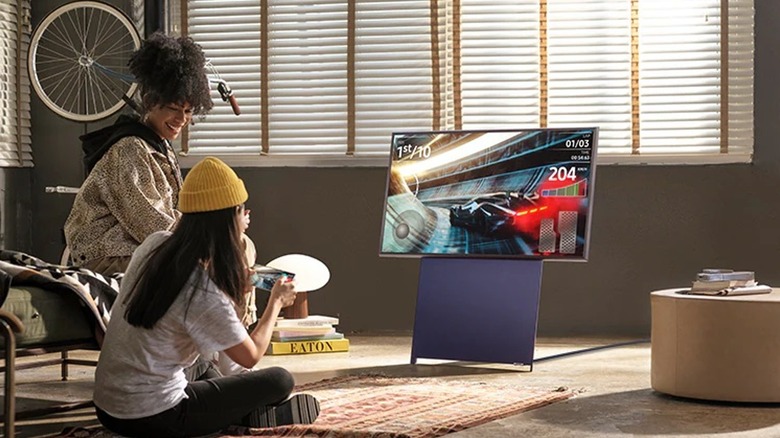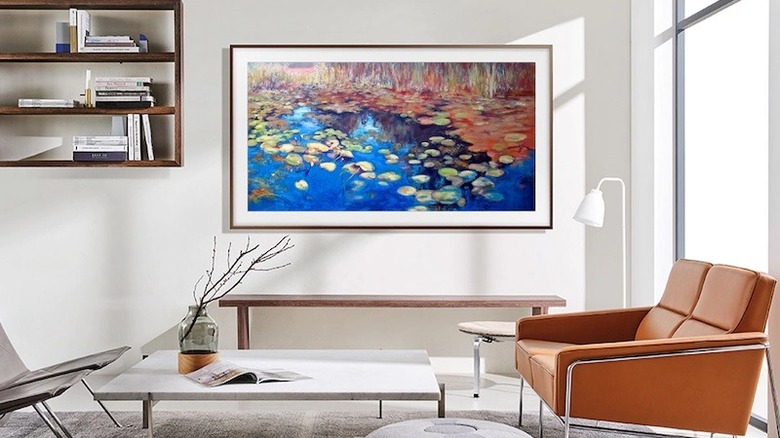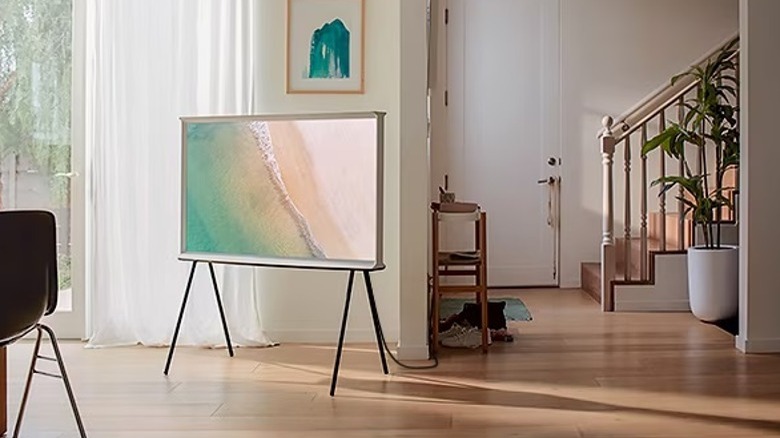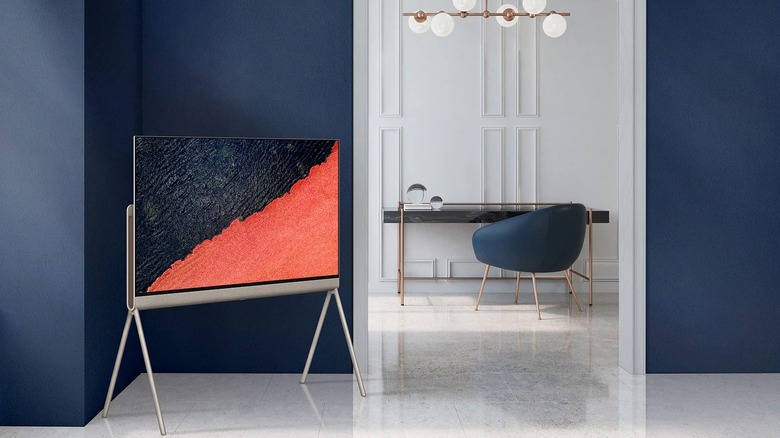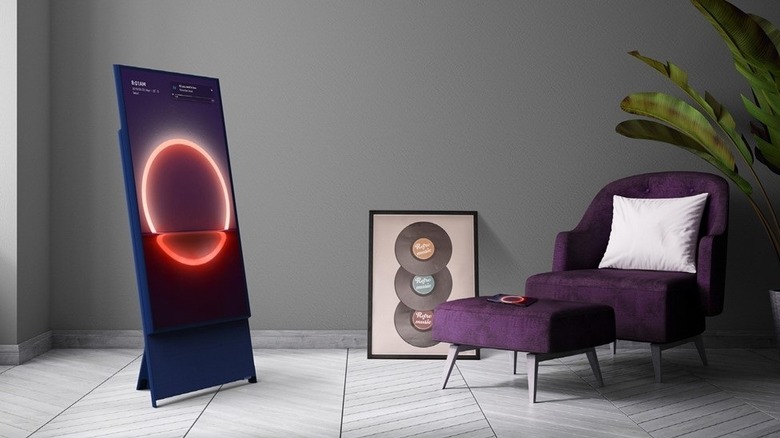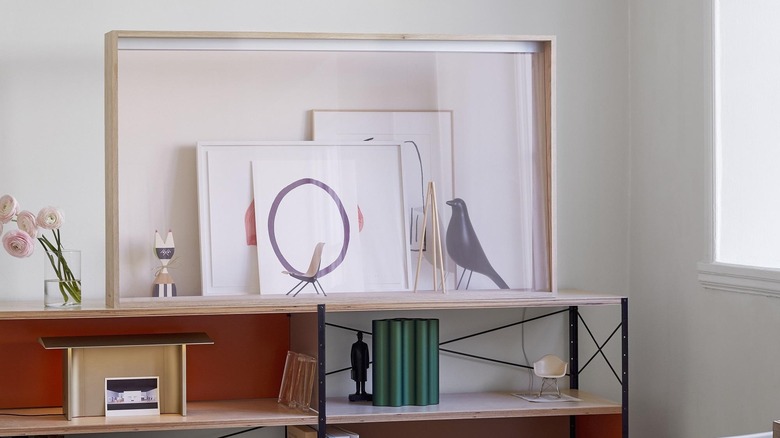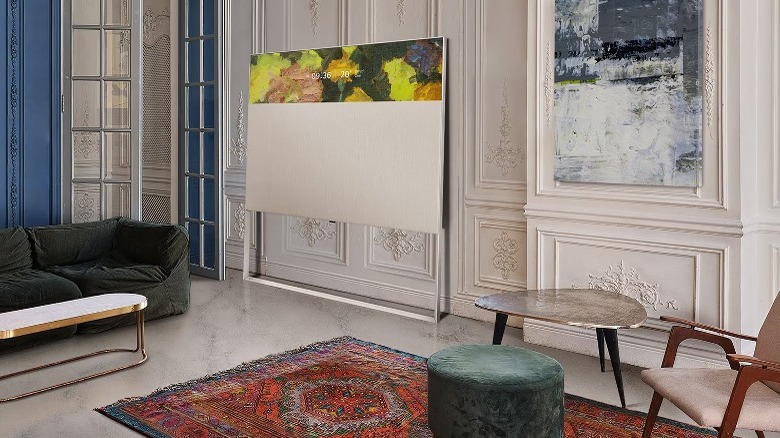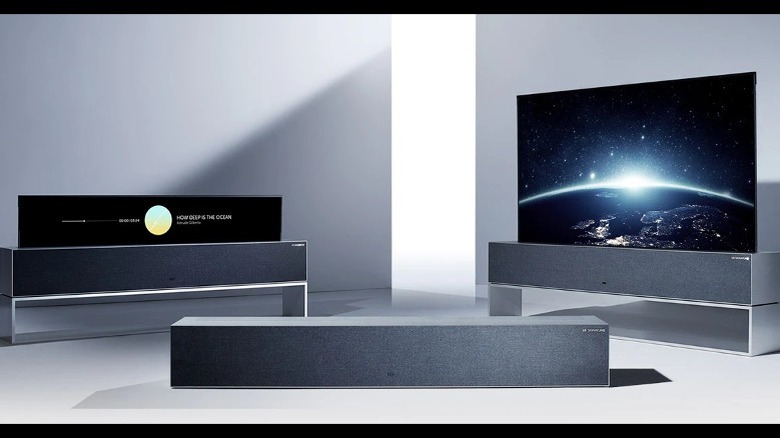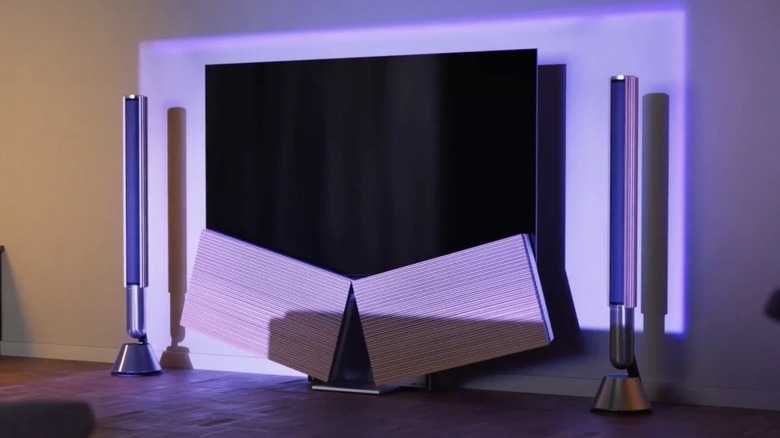8 Unique TVs That Would Look Great In Any Space
We may receive a commission on purchases made from links.
The early days of television were a wild west of invention, experimentation, and innovation which resulted in some of the coolest and weirdest TVs ever made. In those days, televisions were new, expensive, and as much a status symbol as a piece of entertainment equipment. Today, televisions have become an almost universal part of many households.
As the technology evolved for the mass market, TVs were streamlined and simplified. They became more accessible, which is not to be discounted, but the average television lost a lot of its charm in the process. As they became more ubiquitous, they also became more homogenous. Place any selection of modern TVs in a lineup next to one another — even televisions from competing manufacturers — and you might be hard-pressed to tell them apart.
The pendulum of time, however, tends to swing back toward the past and some manufacturers are experimenting with new form factors to give us gadgets with are both familiar and refreshing. Sleek, compact TVs are effective and unobtrusive, but it might be time to reimagine what a modern television can be.
Samsung Frame
Samsung's Frame TV is perhaps the most well-known designer television on the market and its popularity comes down, in large part, to its familiarity. While it does push the boundaries of what a television can be, it does so in a way that is minimally invasive and doesn't sacrifice the day-to-day television experience.
When in use, the Frame looks like just about any other television, save for the stylized bezel around the edge, which is actually a good thing. When you're watching something, you want your TV to look like a TV. That said, the Frame really shines when it's not being watched, so to speak. The Frame is designed to mimic the look of a framed piece of art, hence the name, and it takes its job seriously. When it's idle, the Frame displays a variety of images, including world-famous works of art.
Samsung's anti-glare technology reduces reflections, making your TV look more like a framed piece of art and you control what's on the screen. The Samsung Art Store offers artwork for purchase or subscription, or you can upload your own works of art or photographs to your TV's gallery. You can also customize the bezel to match any décor. Sizes and prices range between 32 inches for $599 and 85 inches for $4,299.
Samsung Serif
Most televisions are designed to blend into the background, almost to be forgotten when they're not in use. That's the philosophy that Samsung's Frame TV leans into, by becoming a literal work of art when it's idle. The Serif, however, goes in the opposite direction, offering a television that's designed to demand space.
Rather than pressing against a wall, The Serif is meant to be admired from a central location, and from every angle, thanks to its stylized frame and stand. Acknowledging that The Serif will take up more living room real estate, Samsung has been conscious about creating value even when the TV is not being watched. Ambient mode allows you to display calming visuals, news, or other information when the TV is idle.
The Serif also features Tap View, which allows you to seamlessly transfer music, photos, movies, and more from compatible Samsung Galaxy phones, with just a tap. If you don't have a Galaxy phone, you can still take advantage of phone mirroring, using Samsung SmartThings or Apple AirPlay. And for the gamers, The Serif has Microsoft's Xbox Gaming Hub built in, so you can stream your favorite Xbox games straight to your TV, no console needed. Samsung's 65-inch The Serif is available for $1,999.
LG Posé
The Posé from LG is meant to stand out in your home. In fact, it insists on it, thanks to the mounted TV frame preventing it from ever sitting flush against a wall. Sleek, angular legs bridge the gap between mid-century and modern design, and the TV's sloping underside curves to reveal a shelf space at the back.
In place of the hard edges and polished surfaces you've come to expect, the Posé offers gentle curves and soft surfaces in a design that's almost cozy. It is available in two sizes, 48 inches or 55 inches for $1,699 or $1,999, respectively.
One of the nicer touches the Posé has to offer is the Cable & Accessory Organizer and Clean Cover, which keep your cables tucked neatly in place at the back of the set. Detachable cable holders also allow you to cleanly run the plug and other cables along the TV's legs, so they remain out of sight. Once you're plugged in and set up, the Posé also has included access to more than 300 LG channels with content from every genre, including sports.
Samsung Sero
Over time, the shape of TVs has evolved to accommodate new types of media, while the format of media has adapted to the types of displays available. For a while, movies and televisions have favored a landscape format with a rectangular shape, but the growing popularity of smartphones has fed a revolution in vertical content. If you want to watch TikTok on your current TV, you can probably do it but you're going to lose most of the screen to buffer bars.
The Sero aims to offer a happy middle ground for folks who want to watch their favorite streaming content and their favorite influencers on the same display. When you're ready to switch media formats, The Sero will change orientations from horizontal to vertical and back again, with the press of a button.
The Sero also features Samsung's anti-reflection technology to give you a consistent picture regardless of lighting conditions. You'll also have access to other popular Samsung features including Samsung Tap, Ambient Mode, and mobile mirroring, with compatible phones. You can also stream Xbox games straight to your TV with the Xbox Gaming Hub. The Sero is available in one size only, 43 inches, and retails for $1,499.
Panasonic Vitrine
The Vitrine is a prototype concept TV made in collaboration between Panasonic and the furniture brand Vitra. The TV was unveiled at Milan Design Week in 2019 and features a nearly transparent display, allowing it to blend seamlessly into the surroundings when it's not in use.
When turned on, it works like any other television, displaying whatever video content you select, but when it's idle the display becomes almost totally transparent. Panasonic takes advantage of the see-through screen to create virtual objects which exist inside your physical space. You can display objects, images, or information like a floating window on an otherwise transparent screen.
The Vitrine remained on display until April 14, 2019, but isn't commercially available. In fact, Panasonic has no announced plans to release the Vitrine to the public, but the company is reviewing feedback from the prototype for a potential future release. Whether that eventual consumer device is the Vitrine, or something built on the Vitrine's foundation, remains to be seen, but only when it's turned on.
LG Easel
As the name suggests, LG's Easel TV attempts to mimic the look and feel of an easel to deliver a gadget which is a television and a piece of interior art at the same time. Although, it takes an admittedly more abstract approach than Samsung's Frame TV, which is essentially going for the same vibe.
The television itself is the familiar black rectangle but it's mounted to a larger frame which also supports a sliding piece of upholstery. The fabric, by the way, comes from premium textile brand Kvadrat and promises both beauty and durability. When you're watching the Easel, the upholstered portion slides down to the floor, leaving the entirety of the screen visible. When idle, you have two content and aesthetic options.
Leaving the upholstered portion down and the screen fully exposed is perfect for displaying artwork, photographs, or other imagery. You can also engage Line View, during which the upholstered portion slides up to obscure most of the screen. A thin line is left visible at the top, where you can display ambient imagery and useful information like the time or the weather. The Easel is just one example of transformative technology allowing your TV to become a part of your space rather than an invader inside of it. The Easel retails for £5,898.98, roughly $7,400 USD.
LG Signature OLED R
The Signature OLED R from LG is perhaps the most transformative television on the market. The screen itself is a flexible OLED display that rolls up into the bottom of the unit when not in use. That bottom unit also contains the sound system and transforms into a sleek side table or shelf when you don't need the screen.
The display is possible thanks to innovative (and expensive) technology which skirts some of the limitations most TVs are up against. As slim as televisions have become, most of them still rely on a backlight to illuminate your pixels and show you your stories. While the footprint of those backlights and other internal mechanics has decreased, the whole configuration remains largely rigid. The Signature skirts those limitations by utilizing self-lit pixels, allowing for a slim and flexible display that can roll up into its housing without exploding into smithereens.
When you want to use the display, you've got two options. You can bring up only a portion of the display, giving you a slim window for news, weather, and other useful information. You can also bring up the entire display, of course, when you're ready to watch a movie or TV show. The privilege will set you back a cool $100,000 and that's only if you can get your hands on one; stock is limited.
Beovision Harmony
Not to be outdone, Bang & Olufsen have created a truly transformative television in the Beovision Harmony. It's about as close as you can get to an actual Transformer in your house, without the threat of interplanetary war.
When it's not in use, the screen is largely nested inside of the stand, which doubles as a speaker system. It's clear that the screen is still there, but it looks almost as if you've put a nightstand in front of it or nested it inside of an oversized Nintendo Switch dock.
The magic happens when the Harmony is switched on. The screen rises up from its resting place while the bottom opens up and hinges outward like a piece of techno-origami to reveal the speakers. Then when you're finished, everything folds back together and slides back into place once more. Watching the Harmony's architecture transform is almost more fun than whatever you were planning to turn on. The only downside is the price, which ranges between $19,425 and $63,075, depending on the size of the screen and the wood you choose. If you really want to spring for the whole package, Bang & Olufsen also offers optional Beolab speakers for an additional $17,000.
